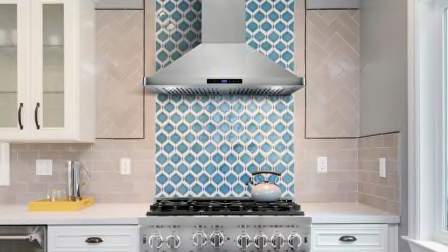How to Clean Your Small Kitchen Appliances
Keep your blender, toaster, coffee maker, and more in tip-top shape
When you shop through retailer links on our site, we may earn affiliate commissions. 100% of the fees we collect are used to support our nonprofit mission. Learn more.

With their curves, knobs, and moving parts, certain small kitchen appliances can get gritty and dirty sitting on a counter, even if they’re not in heavy rotation. And some are harder to clean than others.
“For the majority of our small appliances, we evaluate how easy each model is to clean,” says Ginny Lui, the engineer who oversees our small-appliance testing. “In some cases, the time spent cleaning the appliance may be longer than the time you spent using it.”
Drip Coffee Maker
Dried coffee oils can ruin the taste of even the best coffee blend. After every use, wash the carafe and brew basket of an electric drip coffee maker in dish soap and water, then rinse and dry. Once the hotplate cools, wipe any coffee that may have spilled on it and remove burnt-on stains by using a little baking soda on a damp sponge. To avoid the accumulation of minerals in the tank and water tube, especially if you have hard water, occasionally run equal parts of water and distilled white vinegar through the machine. Then run water through it a couple of times. (Check the manual first. Some coffee makers will suggest a different ratio.) Or use a special coffee-machine cleaning solution.
Below is a drip coffee maker that earns an excellent rating in our convenience test, which includes ease of cleaning. For more choices, check out our full coffee maker ratings and list of best drip coffee makers.
Pod Coffee Maker
Clean your pod coffee maker regularly. Mineral buildup and coffee residue slow brewing; they can also affect the taste. Instructions for some models recommend using filtered or bottled water for brewing. Owner’s manuals typically advise running a cycle of distilled white vinegar through the machine every month or so, but the process differs by model.
A pod coffee maker calls for a similar method, though it might vary a bit. Keurig, for example, sells a special Keurig Descaling Solution ($7 for 14 ounces) which, according to the brand, is the only Keurig-approved cleaning solution for Keurig brewers.
The one-year Keurig warranty excludes damage from using non-Keurig pods and accessories, which could include using another cleaning solution. But after the warranty is up, there’s no reason not to try distilled white vinegar instead. As always, run at least one cycle of just water afterward.
Below is a pod coffee maker that earns a top score for convenience, which includes ease of cleaning. For more choices, check our full coffee maker ratings and list of best pod coffee makers.
Blender and Food Processor
Clean your blender and food processor after each use. Although certain parts may be dishwasher-safe—usually on the top rack only—their odd shapes can make them difficult to secure; hand-washing is therefore strongly advised. Remove the cutting or shredding blade from the bowl, and wash each part separately (to minimize the chance of injury or damage) using a mild detergent in hot water, followed by a thorough rinse in warm water.
Use a toothbrush or a bottle brush to clean off any stuck-on food. Don’t let the cutting blade soak in water or become obscured from view. Carefully wipe metal parts dry with a soft, clean towel; let plastic parts air-dry. Use a mild all-purpose cleaner or a soft cloth dampened with water or distilled white vinegar to clean the motor base.
Below is a blender that aces our convenience test, which includes ease of cleaning. Cleaning isn’t part of our food processor tests, so we don’t have enough data to assess an appliance’s ease of use. For more choices, see our full blender ratings and food processor ratings, and check out our picks of the best blenders and best food processors.
Toaster
It doesn’t take long for a toaster or toaster oven to become filled with crumbs, but most models come with a removable crumb tray that makes for easy cleaning. Before getting started, make sure the device is cool to the touch. Place a plastic garbage bag or a few sheets of newspaper underneath the tray, then carefully slide it out and shake off any crumbs or loose food. Use a damp, soapy sponge or nylon scrubber to remove any baked-on particles, rinse well, and dry with a soft cloth or paper towel. Make sure the tray is completely dry before reinserting it.
If your toaster doesn’t have a crumb tray, turn it upside down over the sink or garbage can and shake out loose crumbs. Use a thin paintbrush or basting brush—never a fork or metal utensil—to loosen any crumbs that may get caught.
Below is a toaster that earns top marks in our ease of cleaning test. For more choices, see our full toaster ratings and list of best toasters.
Toaster Oven
Because you typically use it for broiling and baking as well as toasting, your toaster oven requires more frequent cleaning. Regularly wipe down the exterior walls and the crumb tray with a sponge dampened with water and a drop of mild dishwashing liquid, then wipe down with a damp sponge. Carefully slide out the cooking racks and clean them in the dishwasher or let them soak for 20 to 30 minutes in hot, soapy water. Use a damp, sudsy cloth to clean the glass door, wipe off any leftover soap with a damp sponge, and dry with a clean towel.
The interior walls of most toaster ovens have a “continuous clean” coating that helps ward off stains and splatters, but that can be damaged by metal scouring pads and abrasive cleaners. To remove any burnt-on food from inside a toaster oven, use a polyester or nylon scrubber dampened with water, but take care not to touch the heating elements. Make sure all parts are completely dry before using the toaster oven.
Our toaster testers found the model below a cinch to clean. For more choices, see our full toaster oven ratings and list of best toaster ovens.
Microwave Oven
Use a mild cleaner and soft cloth to clean the exterior of your microwave oven. Wipe up any spills in the interior immediately. To remove cooking stains, wipe the walls and floor of the oven with a hot, damp cloth. Wash removable parts, such as the turntable, in hot water and dishwashing liquid.
To mask odors, place a bowl of water containing a quarter-cup of lemon juice in the oven and run it on high for 1 minute. Remove the bowl and wipe the oven cavity, using the condensation that will have formed to clean it. Wipe stains using plain water and repeat if necessary. Scrape off stubborn stains with a plastic credit card. But never scrape the inner surface of the window, because that might damage any microwave-blocking finish. To extend your microwave’s life, use preprogrammed settings and don’t run it on empty.
The countertop microwave below earns top marks in our ease of use test, which includes cleaning. For more choices, including over-the-range models, see our full microwave ratings and list of best microwaves.
How to Make Your Appliances Shine
You might not be able to control all the messes in your kitchen, but a Consumer Reports expert, Sara Morrow, reveals some simple steps for getting your microwave oven sparkling clean.
This article was adapted from Consumer Reports’ book “How to Clean Practically Everything.”




















